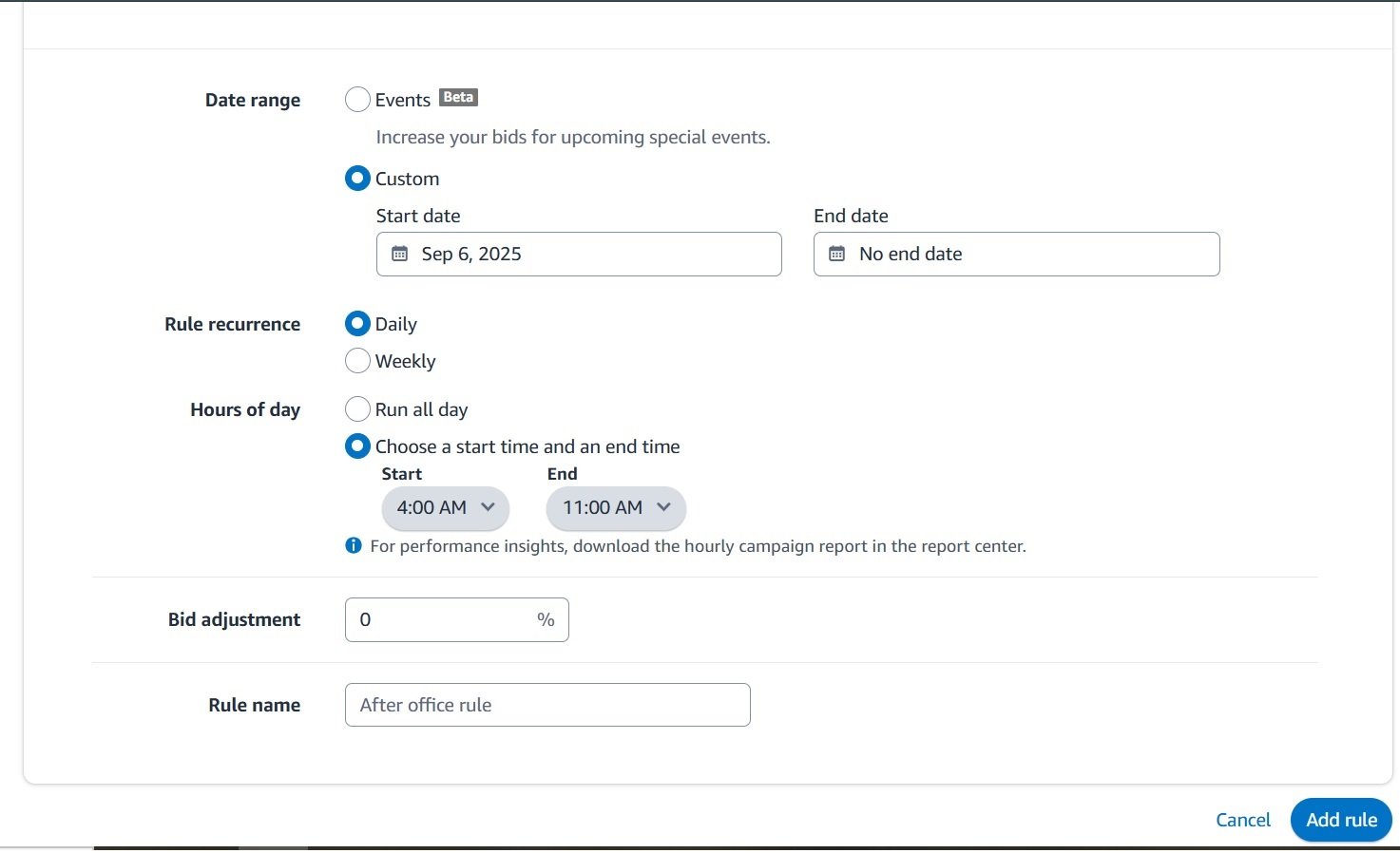Amazon CPCs have been climbing year after year. In 2018, the average was around $0.71, rising to $1.20 in 2020, and crossing $1.80 by 2023. This steady increase means sellers are paying more for clicks, often leading to higher ACOS if campaigns aren’t optimized.
Just running basic PPC campaigns and hoping for the best isn’t an Amazon advertising strategy; it’s a recipe for burning cash. If you’re dealing with stagnant sales and high ad spend, it’s tough to know what to fix first.
In 2025, winning on Amazon means thinking bigger than just Sponsored Products. It requires building a complete system that uses different ad types to find new customers, bring old ones back, and protect your brand’s space on the digital shelf.
Each section below provides practical implementation details to help you move from simply spending money on ads to investing in a cohesive, growth-focused Amazon PPC strategy. Let’s get started.
1. Keyword Research & Harvesting
Keyword research is the main part of the Amazon advertising strategy. You’ll constantly research new, relevant, and high-performing search terms while simultaneously filtering out wasteful ones.
Harvesting is the expert’s trick: continuously moving proven search terms from broad or automatic campaigns into exact match manual campaigns, giving you maximum control and efficiency. Let’s break down how to put this into action.
- Start with Keyword Research Tools: Use tools like Helium 10 Cerebro (screenshot below), Jungle Scout, or even Amazon’s brand analytics to see what keywords your top competitors are ranking for. For more details our detailed guide on keyword research for Amazon.

- Start with Auto Close Match Campaigns: Launch Automatic campaigns to discover a wide range of search terms your products rank for. Set a competitive bid to ensure impressions. For new product launches, avoid running auto campaigns from day one. Wait 2–3 weeks before starting them. Create seperate campaign for each match type. Create individual campaigns for Close Match, Loose Match, Substitutes, and Complements. Each targets different search terms or ASINs, with Close Match focusing on closely related keywords and ASINs.
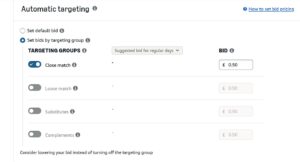
- Utilize Amazon Search Term Reports: Regularly (weekly/bi-weekly) download your Search Term Reports from Seller Central. Filter by conversion rate, ACoS, orders, and sales to identify performing terms.
2. Smart Bidding Strategies
Your bidding strategy decides how Amazon spends your budget and how much you actually pay per click. For example if you set $2.50 bid, it doesn’t always mean you’ll pay $2.50 and the final cost depends on both the strategy you choose and the placement where your ad appears.

Amazon divides placements into three main types:
- Top of search (first page) → the premium spot at the top of Amazon search results.
- Rest of search → all other positions within search results beyond the top slots.
- Product detail pages → ads appearing on competitor or related product listings.
Now let’s look at how each bidding strategy affects your $2.50 bid across these placements.
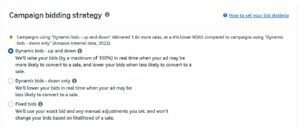
1. Dynamic bids — up and down
How it works: Amazon raises or lowers your bid in real time based on conversion likelihood.
- Top of search: can increase by up to 100% → $2.50 can rise to $5.00, or fall below $2.50 if signals are weak.
- Rest of search: can increase by up to 50% → $2.50 can rise to $3.75, or drop lower.
- Product detail pages: treated the same as rest of search → $2.50 can rise to $3.75, or drop lower.
2. Dynamic bids — down only
How it works: Amazon only reduces your bid when conversion chance is low. It never raises it.
- Top of search: stays at $2.50 (unless you add a manual placement multiplier).
- Rest of search: may drop below $2.50 if conversion signals are weak.
- Product detail pages: may also drop below $2.50.
3. Fixed bids
How it works: Amazon uses the exact bid you set no increases, no decreases. Manual placement adjustments still apply.
- Top of search: always $2.50 (or higher if you add a placement multiplier).
- Rest of search: always $2.50.
- Product detail pages: always $2.50.
How to Optimize Bidding Strategies with Placements
The bidding strategy you choose shapes your entire PPC performance. Here’s how to make it work for you:
- Start with “Down Only” for control and profitability. Use small placement adjustments (10–30%) on top of search after checking conversion data.
- Use “Up and Down” only during agressive launches or growth stage to capture more top-of-search traffic. Watch spend closely since CPC can double.
- Use “Fixed Bids” for retargeting or when you know the exact CPC range that works. Pair with strong placement adjustments to force visibility where you want it.
- Always review the Placement Report — it shows which placements convert best. Gradually shift budget toward the most profitable ones.
3. Budget Allocation Across Campaigns
Effective budget allocation is paramount to any successful Amazon advertising strategy. It ensures your ad spend is precisely directed towards the most profitable areas, maximizing your return on investment.
This means prioritizing campaigns based on their proven performance, their strategic importance (like launching new products versus nurturing bestsellers), and your overarching business objectives.
In the table below of one of our products, we use color coding to manage campaigns. Campaigns with strong conversion rates and low ACOS are given higher bids and budgets, while those with higher ACOS have reduced budgets. Campaigns generating zero sales are paused.

Here’s how you can apply this in your campaigns.
- Define Your Campaign Tiers:
- Tier 1 (High Priority): High-performing, profitable campaigns (ACoS <target ACoS, high sales), new product launches, organic ranking campaigns.
- Tier 2 (Growth/Maintenance): Moderate-performing campaigns, brand defense, competitor targeting, brand awareness campaigns.
- Tier 3 (Discovery/Testing): Auto campaigns, broad match, new keyword/ASIN tests.
- Allocate Based on ACoS & ROAS: Routinely review campaign performance.
- High ROAS / Low ACoS Campaigns: Allocate a larger portion of your budget (Allocate 60%-70% of ad budget) here. These are your money-makers.
- Underperforming Campaigns: Lower budget or pause if ACoS remains high (>100%) and does not improve.
- New Product Launches: Front-load budget for the first 4-6 weeks to gain organic ranks. Be prepared for a higher initial ACoS.
- Utilize Campaign Budgets & Portfolio Budgets:
- Individual Campaign Budgets: Set bids & daily budgets for each campaign based on its tier and performance.
- Portfolio Budgets: If you have several campaigns for one product line or brand, use portfolios to set a total budget so Amazon can allocate spending between campaigns based on performance, which is helpful for growth.
- Monitor Budget Depletion: Review your campaigns each day to find those reaching their budget limit too soon. This shows lost opportunities. Raise the budget for strong campaigns that often run out.
4. Clear Campaign Structure
An organized campaign structure is the bedrock for control, scalability, and precise data analysis. It empowers you to swiftly identify what’s working (and more importantly, what isn’t) at a glance, making the entire optimization process significantly more efficient and less prone to costly mistakes.
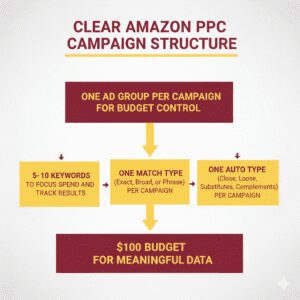
To make this strategy practical, here’s what to do next.
- “SPAG” (Single Product Ad Group) or “SKAG” (Single Keyword Ad Group) Principle:
- SPAG: For Sponsored Products, create one campaign per product (ASIN) and then use one ad groups within that campaign. This provides product-level insights.
- SKAG (Advanced): For high-volume, relevant keywords, create a separate ad group for each exact match keyword. This gives you ultimate bid control per keyword.
- Campaign Naming Convention: Implement a consistent, descriptive naming convention.
- Example: BRAND_PRODUCTLINE_PRODUCTNAME_TARGETINGTYPE_MATCHTYPE_GOAL
- ACME_WidgetPro_RedWidget_KWD_Exact_Sales
- ACME_WidgetPro_RedWidget_Auto_Discovery
- ACME_WidgetPro_Competitor_ASIN_Defense
- Separate Campaigns by Targeting Type:
- Automatic Campaigns: For keyword discovery and broad reach.
- Manual Keyword Campaigns: Exact, Phrase, Broad match types should be in separate campaigns for precise bidding.
ASIN/Product Targeting Campaigns: Target weak competitor ASINs - Category Targeting Campaigns: Target entire product categories or subcategories.
- Campaigns by Goal:
- Discovery Campaigns: (Auto, Broad Match) Focused on finding new keywords.
- Single Keyword Campaigns (SKC): (Exact Match) Focused on organic ranking on top relevant keywords.
- Defense Campaigns: (Brand Keywords, Brand ASINs) Protecting your brand and market share.
- Portfolios: Group related campaigns (e.g., all campaigns for a specific product line) into portfolios for easier budget management and holistic reporting.
5. Mix of Sponsored Products, Brands & Display Ads
Amazon provides a powerful suite of ad formats, each uniquely designed to serve distinct advertising purposes within your overall Amazon advertising strategy. Sponsored Products are your workhorses, driving immediate traffic to individual product listings. Sponsored Brands improves your brand awareness, promoting a collection of products or your entire storefront. Sponsored Display expands your reach both on and off Amazon, targeting shoppers based on interests, product views, or even past purchases, giving you remarkable flexibility. Let’s break down how to put this into action.
Sponsored Products (Foundation):
Budget Allocation: Allocate approximately 70 to 80 percent of your budget to Sponsored Products advertising.
Spending Priority: Prioritize spending on Sponsored Products Exact campaigns within this budget allocation.
Sponsored Brands (Brand Building & Diversification):
Headline Ads: Use these to drive traffic to your Brand Store or a custom landing page showcasing your top sellers or new arrivals.
Product Collection Ads: Display 3-5 complementary products that encourage cross-selling.
Video Ads: Leverage video to tell your brand story or demonstrate product features directly in search results – highly engaging.
Sponsored Display (Reach & Retargeting):
Views Remarketing: Crucial for converting hesitant shoppers. Target customers who viewed your product but didn’t purchase. Segment these audiences (e.g., viewed in last 7 days, 14 days) and offer different messaging/bids.
Purchases Remarketing: Target customers who purchased your product to promote complementary items or encourage repeat purchases.
Product Targeting: Target specific product detail pages or categories where your product would be relevant (e.g., targeting a competitor’s listing).
Audience Targeting (Interests/Lifestyles): Expand your reach to shoppers with interests relevant to your product, both on and off Amazon.
Custom Creatives: For SD, design compelling ad creatives (images/videos) that stand out and feature clear calls to action. A/B test different creatives.
6. Match Types & Negative Keywords
Match types – Exact, Phrase, and Broad – in your Sponsored Products campaigns is absolutely critical for controlling relevance and spend.
Exact Match gives you surgical precision over specific keywords, Phrase Match allows for some variation while preserving word order, and Broad Match captures a wide array of related terms. This can be applied directly in your PPC setup as follows:
- Exact Match (High Intent, High Control):
- Target High Performers: Move all keywords that consistently generate sales with a good ACoS from your auto and broad campaigns into exact match manual campaigns.
- Aggressive Bidding: Bid higher on exact match keywords as they indicate strong purchase intent and have higher conversion rates.
- SKAG Structure: For your most critical exact match keywords, consider a “Single Keyword Ad Group” (SKAG) structure for ultimate control.
- Phrase & Broad Match:
- Capture Variations: Utilize phrase or Broad+ match for close variations of key phrases with specific word order (e.g., “red running shoes” triggers “buy red running shoes” but not “running red shoes”).
- Broad & Phrase for Ranking Push
Running Broad and Phrase alongside your Exact match ranking campaign captures variations of the main keyword. For example, targeting “running shoes” in Broad and Phrase brings in related searches, which strengthens keyword relevance signals and helps the exact keyword rank faster. - Test New Keywords: Employ phrase & broad match to trial new keywords identified in research before switching to exact match.
- Negative Keywords (Budget Protection):
- Routine Search Term Review: Conduct weekly or bi-weekly evaluations of your Search Term Reports.
- Remove Irrelevant Terms: Exclude any non-relevant search terms by adding them as negative matches.
- Address Poor Performers: Exclude terms with high spend and no sales or consistently high ACoS that cannot be optimized.
7. ASIN & SKU Prioritization
In your catalog, concentrate ad spend on the 20% of ASINs or SKUs that will yield 80% of results. This focus helps achieve business goals like boosting profit, increasing new item visibility, or reducing surplus stock efficiently, forming a crucial part of a successful Amazon PPC strategy. Here’s how you can execute it in your account:
- Categorize Your ASINs/SKUs:
- Hero/Cash Cow ASINs: High-performing, profitable products with strong organic rankings and sales.
- Strategic Growth ASINs: Products with potential but need more investment to scale.
- Loss Leader ASINs: Products with lower margins but high customer acquisition value or essential for a product line.
- Liquidation ASINs: Products you need to clear out due to overstock or discontinuation.
- Allocate Budget Strategically:
- Hero ASINs: Dedicate 70-80% of the budget to maintain top brand positions and grow using profitable keywords.
- Strategic Growth ASINs: Dedicate 10 to 20 percent of the budget. Begin with phrase or broad match to explore, then switch to exact match once effective.
- Liquidation ASINs: Run targeted campaigns with high bids to sell inventory quickly, focusing on volume rather than ACoS briefly.
8. Product Page Optimization for CVR
Your Amazon product page is the ultimate destination for every ad click. If product listings is not optimized for conversion (CVR), all your diligent Amazon advertising strategy efforts and precious ad spend will be squandered. A high-converting product page directly translates to a lower ACoS because you’re maximizing the value and sales potential of every single paid click that arrives. This means scrutinizing and enhancing every element, from compelling images to persuasive customer reviews.
Here’s an Amazon SEO and Conversion Rate Optimization checklist to track every element of your listing. You can create a similar sheet for your products. Remember, Amazon PPC only drives traffic, if shoppers don’t convert, the issue lies with the listing, not the ads.

Here’s a simple way to execute this approach.
- High-Quality, Engaging Images (All 9 Slots):
- Main Image: Professional, high-resolution, white background, filling 85%+ of the frame.
- Lifestyle Images: Show product in use, diverse models/settings, evoke emotion.
- Infographic Images: Highlight key features, benefits, dimensions, use cases.
- Video: Essential for demonstrating features, benefits, and building trust.
- A/B Test Images: Use Amazon’s ‘Manage Your Experiments’ tool to test different main images or lifestyle shots.
- Compelling Title (Keyword Rich & Benefit-Oriented):
- Include your most important keywords in first 70 characters.
- Clearly state product name, brand, key features/benefits, and quantity.
- Aim for clarity and conciseness, avoiding keyword stuffing.
- Benefit-Driven Bullet Points:
- Focus on benefits, not just features. How does it solve a customer’s problem?
- Include 2 relevant keywords per bullet point naturally.
- Address common customer questions or pain points.
- A+ Content (Enhanced Brand Content):
- Tell Your Brand Story: Use rich media, modules, videos, and text to showcase your brand’s unique value proposition.
- Cross-Promote: Link to other products in your brand.
- Customer Reviews & Ratings
- Gather Sufficient Reviews: Ensure you have collected between 15 to 20 reviews before launching any advertising campaigns.
- Maintain High Ratings: Aim to keep your ratings above 4 to improve the conversion rate.
- Backend Keywords: Utilize all available 500-bytes backend search term fields in Seller Central to capture additional relevant keywords that might not fit naturally in your title or bullet points.
- Competitive Pricing: Ensure your pricing is competitive within your category. Run promotions or coupons strategically.
- Inventory & Buy Box: Always maintain sufficient inventory. If you lose the Buy Box, your ads will stop running.
9. Bid Adjustments by Placement
Understanding where your ads appear on Amazon’s pages is just as important as the keywords you target. Amazon allows you to set specific bid adjustments for different placements: “Top of search (first page)” and “Product pages.”
This granular control is a powerful lever within your Amazon advertising strategy, enabling you to fcous your spent where it matters most, or pull back where performance isn’t meeting your targets. Below is how you can apply this on your campaigns.
- Analyze Placement Performance: Go to your campaign manager, select a campaign, and navigate to the “Placements” tab. Review the “Top of search (first page),” “Product pages,” and “Rest of search” performance for key metrics like Impressions, Clicks, ACoS, and Conversion Rate.
- Identify High-Performing Placements: Look for placements that consistently deliver a low ACoS and high conversion rate, even if the spend is relatively low.
- Adjust Bids Based on Performance: If your product consistently converts well from the “Top of search (first page)” but you’re not getting enough impressions, apply a positive bid adjustment (e.g., +20% to +100%). This pushes your ad higher in search results, capturing more high-intent shoppers. Start with conservative increases and monitor closely.
- Monitor and Refine: Bid adjustments are not static. Continuously monitor the performance of your adjusted bids, typically on a weekly basis, and make further tweaks based on the data. If an increase leads to an unacceptably high ACoS, reduce the adjustment.
The screenshot below shows that for this specific campaign, Product Pages placement resulted in the lowest ACOS of 19%, so a 30% bid increase was applied to this placement. This way, the product will gain more visibility at this specific keyword and placement, which is expected to generate better results.

10. Bid Adjustments with RPC Model
Most sellers adjust bids randomly, raising or lowering them without a clear reason. A better way is to use the RPC Model (Revenue Per Click), which links your bids to actual performance data. It shows exactly how much you can afford to pay per click while staying within your profit goals.
Step 1: Calculate RPC
RPC = Total Sales ÷ Clicks
This tells you how much revenue you earn per click on average.
Step 2: Find the Target Bid
Target Bid = RPC × Target ACOS
Example:
If a keyword generated $100 in sales from 20 clicks:
RPC = 100 ÷ 20 = $5
If your target ACOS is 30% (0.3):Target Bid = 5 × 0.3 = $1.50
So you should bid $1.50 to maintain your 30% ACOS target.
11. Ranking the Near-Rank Keywords
Many sellers overlook the immense potential of keywords where their product already holds a respectable, but not dominant, organic rank typically between position 25 and 45. These “near-rank” keywords are ripe for acceleration.
Here’s a screenshot of keyword tracking for one of the brand’s products we manage. The tracking shows us real-time positions for terms like ‘water bottles.’ For example, the organic rank is 25, and by increasing spend on the Sponsored Products exact campaign, we can push this keyword higher.
![]()
- Identify Near-Rank Keywords:
- Use Keyword Tracking Tools: Employ tools like Helium 10, Jungle Scout, or Seller Central’s Brand Analytics to find keywords where your product is organically ranking between positions 20 and 45.
- Filter for Relevancy & Volume: Focus on highly relevant keywords with decent search volume.
- Use Keyword Tracking Tools: Employ tools like Helium 10, Jungle Scout, or Seller Central’s Brand Analytics to find keywords where your product is organically ranking between positions 20 and 45.
- Launch Dedicated Exact Match Campaigns: Create new, specific Sponsored Products campaigns for these identified near-rank keywords, using exact match targeting. Bid competitively on these exact match keywords. Your goal here is not just profitability today but organic rank improvement tomorrow. You might accept a slightly higher ACoS for these campaigns initially.
- Monitor Organic Rank (Daily/Weekly): Use your keyword tracking tools to monitor the organic rank of these targeted keywords daily or every few days. You should see movement upwards.
- Optimize Continuously: Once organic rank improves significantly (e.g., enters top 10), you can gradually reduce your PPC bids to maintain position while improving ACoS.
12. Dayparting Strategy
Dayparting is the strategic practice of scheduling your ads to run or adjust bids during specific times of the day or days of the week. This refined approach within your Amazon PPC strategy leverages data on when your audience is most active and most likely to convert.
By aligning your ad spend with peak performance hours, you can significantly reduce wasted budget and boost efficiency, rather than simply letting campaigns run 24/7 without consideration for actual buyer behavior. To setup dayparting in Amazon PPC campaigns, follow these steps.
- Access Performance Data by Time: Login to Amazon Ads Console → Reports → Create Report → Sponsored Products → Choose Campaign → Time Unit = Hourly → Select Date Range → Run Report → Download CSV/Excel.
- Analyze Peak Performance Hours:
- Identify the hours of the day and days of the week where your campaigns consistently have the lowest ACoS, highest conversion rates, and most sales.
- Look for patterns: Are weekends stronger than weekdays? Do sales spike in the evenings or mornings?
- Implement Bid Adjustments (Rule-Based):
- Go to Seller Central → Campaign Manager → Select your campaign → Settings → Scroll to Campaign rules → Click Create rule → Choose Date range (Custom or Event) → Select Daily or Weekly recurrence → Under Hours of day, pick Start and End time → Enter Bid adjustment % → Name the rule → Click Add rule.poor performance.

13. Search-Term Report Analysis
The Search Term Report (STR) is an indispensable treasure trove of customer intent data, arguably the single most important report for optimizing your Amazon advertising strategy.
It details the exact search queries customers used that led to a click on your ads. By meticulously dissecting this report, you can unearth profitable new keywords, identify irrelevant terms to negative match, and gain profound insights into how your target audience truly searches for products, continuously refining your overall Amazon advertising strategy. Here’s how you can put this into action.
- Download Regularly: Make downloading your Search Term Report a weekly or bi-weekly habit. Go to Seller Central > Advertising > Campaign Manager > Reports > Create Report > Sponsored Products > Search Term >
- Filter and Sort for Action:
High Spend, Low Sales (Wasted Spend)
Excel Filter:
Spent > 50% of Product PriceAND7 Day Total Sales = 0Action: Pause or add as negative keywords/ASINs.

High Impressions, Low CTR (Irrelevant Traffic)
Excel Filter:
Impressions > 1000ANDCTR < 0.3%Action: Refine targeting or placement e.g increase bid for top of the search

Profitable Search Terms to Scale
Excel Filter:
ROAS > 3ANDSpend < 150Action: Raise bids or move to Exact Match campaign.
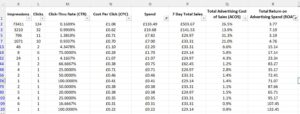
New Search Terms with Potential
Excel Filter: Impressions > 500 AND CTR > 0.5% AND Orders < 2
Action: Move to test campaigns.

- Optimize Existing Keywords:
- If an existing keyword in a manual campaign is performing poorly, use STR to see which search terms it’s matching to. This might reveal that the keyword is too broad, or that specific variations are driving up costs.
- Action: Adjust bids, or add specific negative keywords to refine the targeting of your existing manual keywords.
- Refine Product Targeting: For campaigns targeting ASINs or categories, the STAR can also show you what search terms led customers to those product pages before seeing your ad. This can provide insights for new product targeting ideas.
- Continuously Repeat: The market is dynamic. New search terms emerge, and customer behavior shifts. Consistent search term analysis is non-negotiable for sustained PPC success.
14. Continuous Optimization
“Set it and forget it” is the death knell of any Amazon advertising strategy. True success stems from a commitment to relentless, continuous optimization. The Amazon marketplace is a living, breathing entity, with constant shifts in customer behavior, competitor actions, and Amazon’s own algorithms. By embracing an iterative cycle of analysis, adjustment, and testing, you ensure your campaigns remain agile, efficient, and consistently outperform the competition.
- Establish a Routine Optimization Schedule:
- Daily: Check budget pacing, identify urgent negative keywords from search term reports, and ensure no critical campaigns are paused due to being out of stock.
- Weekly: Full review of Search Term Reports (harvesting, negating), bid adjustments (up/down), budget re-allocation, and performance review of new tests.
- Monthly: Comprehensive campaign deep dive. Analyze trends over time (30-60-90 days), review ACoS/ROAS/TACoS targets, evaluate product page performance, plan new creative tests, and assess overall business objectives.
- Quarterly/Seasonal: Strategic review of market conditions, competitor movements, upcoming promotions, and major seasonal shifts.
- Data-Driven Decision Making: Never make changes based on gut feelings. Every adjustment to bids, budgets, match types, or creatives should be informed by specific data points and a clear hypothesis.
- Test, Learn, Iterate:
- A/B Testing: Actively run A/B tests for product listings (via ‘Manage Your Experiments’) and ad creatives (where available).
- Small Changes First: Start with small bid or budget adjustments (e.g., 5-10%) to understand their impact before making larger shifts.
- Document Changes: Keep a log of all significant changes made, including the date, campaign, what was changed, and the expected outcome. This helps in attributing results.
- Focus on the Big Picture (TACoS): While ACoS is crucial for individual campaigns, always keep an eye on TACoS. Ensure your optimizations are contributing to overall brand growth and profitability, not just immediate ad efficiency.
- Address Performance Gaps: If a campaign or product consistently underperforms despite optimizations, don’t be afraid to pause it or significantly reduce its budget. Reallocate those resources to areas with higher potential.
15. Audience Targeting & Retargeting
Moving beyond mere keywords, sophisticated audience targeting allows you to precisely reach specific groups of shoppers based on their demographics, interests, and—most importantly—their past behavior on Amazon. Retargeting (or remarketing) is an incredibly potent facet of any Amazon advertising strategy, specifically designed to re-engage shoppers who’ve already expressed interest in your products or brand, thereby dramatically increasing conversion probabilities.
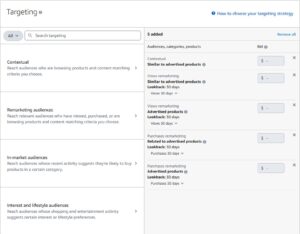
- Use Sponsored Display (SD) for On/Off Amazon Targeting:
- Views Remarketing: Your highest ROI audience. Target shoppers who viewed your product detail page (PDP) but didn’t purchase.
- Segment by Recency: Create audiences for 7-day, 14-day, 30-day viewers. Bid higher on more recent viewers.
- Custom Creatives: Use dynamic creative optimization to show them the exact product they viewed.
- Offer Incentives: Consider adding a coupon to remarketing ads for those who viewed multiple times or added to cart but didn’t buy.
- Purchases Remarketing:
- Cross-Sell: Target customers who bought Product A to suggest Product B (e.g., coffee maker purchasers targeted with coffee bean ads).
- Repeat Purchases: Remind customers to reorder consumable products.
- Audience Interests & Lifestyles: Target shoppers based on their long-term shopping patterns or interests (e.g., “outdoor enthusiasts,” “tech gadget lovers”). Use this for top-of-funnel awareness.
- Views Remarketing: Your highest ROI audience. Target shoppers who viewed your product detail page (PDP) but didn’t purchase.
- Sponsored Brands Custom Audiences (Newer Feature):
- Reach Shoppers who visited your Brand Store or Product Detail Pages: Use this for Sponsored Brands campaigns to re-engage with highly relevant audiences at the top of search.
- Reach Shoppers who visited your Brand Store or Product Detail Pages: Use this for Sponsored Brands campaigns to re-engage with highly relevant audiences at the top of search.
- Campaign Structure for Audiences:
- Create separate campaigns or ad groups for different audience segments (e.g., “SD – Views 7-Day,” “SD – Competitor Purchasers,” “DSP – In-Market Audiences”) to control bids and analyze performance independently.
- Create separate campaigns or ad groups for different audience segments (e.g., “SD – Views 7-Day,” “SD – Competitor Purchasers,” “DSP – In-Market Audiences”) to control bids and analyze performance independently.
- Creative Tailoring:
- Remarketing: Ad creatives should focus on the product(s) viewed and a clear call to action (e.g., “Don’t miss out!”).
- Awareness: Creatives should highlight brand benefits and introduce your product to a new audience.
- Frequency Capping: Implement frequency caps in DSP to avoid ad fatigue and wasted impressions (e.g., show an ad 3-5 times per day to a user).
16. Brand Awareness Campaigns
While many Amazon advertisers are laser-focused solely on direct response and immediate sales, cultivating strong brand awareness is a critical, long-term pillar of any sustainable Amazon advertising strategy.
These campaigns introduce your brand and products to new audiences, diligently foster trust, and ultimately drive significant organic demand. Though they might exhibit a higher ACoS initially, their investment can yield substantial increases in total sales and cultivate invaluable brand loyalty over time. Here’s a simple way to execute this approach.
- Define Your Target Audience:
- Who are you trying to reach? What are their interests, demographics, and shopping behaviors?
- Use Amazon’s audience segments (In-Market, Lifestyle) in Sponsored Display and DSP.
- Leverage Sponsored Brands for Top of Search Dominance:
- Headline Ads to Brand Store: Drive traffic to your Amazon Brand Store, which is designed to showcase your brand’s story and product catalog.
- Brand Video Ads: Highly engaging format that captures attention in search results. Use compelling visuals and a strong brand message.
- Custom Images for Sponsored Brands: Use lifestyle images that resonate with your target audience, not just product shots.

- Sponsored Display & Amazon DSP for Broad Reach:
- Interest/Lifestyle Targeting: Target audiences based on their demonstrated interests (e.g., “fitness enthusiasts” for a protein supplement brand).
- Category Targeting: Target broad categories where your product fits to introduce your brand to relevant shoppers.
- Geographic & Demographic Targeting: Use DSP to target specific regions or demographics if relevant to your brand.
- On & Off-Amazon Placements: Expand your reach beyond Amazon search results.
- Compelling Creative is Key:
- Focus on Brand Story/USP: What makes your brand unique? What problem do you solve?
- High-Quality Visuals: Professional imagery and video that aligns with your brand identity.
- Clear Messaging: Simple, memorable, and impactful.
- A/B Test Creatives: Continuously test different ad variations to see what resonates best with new audiences.
- Measure Beyond ACoS:
- Brand Search Lift: Monitor if your branded search volume increases
Making Your Amazon Ad Strategy Work for You
For 90% of sellers, the journey begins with Sponsored Products. This is your foundation. It’s where you’ll drive immediate sales, validate your product-market fit, and harvest the high-intent keywords that fuel your entire advertising ecosystem. Don’t move on until this part of your strategy is stable and profitable.
Once your Sponsored Products campaigns are humming along, it’s time to build the walls with Sponsored Brands. Use the keyword data you’ve collected to create campaigns that build brand awareness and capture top-of-funnel traffic. This is how you transition from just selling a product to building a recognizable brand that shoppers trust.
With a solid foundation and structure in place, you can add the finishing touches. Sponsored Display acts like your security system, retargeting shoppers who visited your listing but didn’t buy, bringing them back to complete the purchase. Amazon Stores become your beautifully designed showroom, giving customers a central place to explore your entire product line.
The key is to remember that this is a marathon, not a sprint. Your strategy shouldn’t be set in stone. It needs to be a living, breathing plan that you constantly monitor, test, and refine. What works today might not work in six months.
New ad types will emerge, and customer behavior will shift. The most successful sellers are the ones who stay curious, embrace the data, and are always willing to adapt.
So, pick your starting point, focus on mastering it, and then thoughtfully layer on the next piece of your advertising puzzle. You’ve got the blueprint; now it’s time to start building.
Amazon Advertising Strategy: Q&A Section
1. How Do I Advertise On Amazon?
You can advertise by setting up Sponsored Product, Sponsored Brand, or Sponsored Display campaigns inside Amazon Ads Console. Start by selecting your ASINs, setting a daily budget, choosing match types (broad, phrase, exact), and adding target keywords or products.
2. What Does Sponsored Mean On Amazon?
“Sponsored” refers to paid ads that appear within Amazon’s search results or product pages. Sellers pay when a shopper clicks the ad, helping gain more exposure in search results and sales for selected ASINs.
3. What Are Amazon Sponsored Products?
These are pay-per-click ads promoting individual products directly in search results and competitor listings. They’re ideal for driving organic ranking and conversions for both new and established products.
4. How To Find Keywords For Amazon PPC?
Use tools like Helium10, Amazon Brand Analytics (Top Search Terms), and Search Query Performance reports. You can also study Amazon PPC Search Term Reports to find converting terms and negative out irrelevant ones.
5. How Should I Optimize Bids For New Keywords?
Start with a moderate bid (slightly higher than minmum recommended by Amazon) to gather data. Once clicks and conversions start rolling in, calculate RPC and adjust bids up or down based on performance to meet your target ACoS.
6. What Is ACoS In Amazon PPC?
ACoS (Advertising Cost of Sales) = (Ad Spend ÷ Sales) × 100. It helps you measure how much you spend to make a sale. Lower ACoS usually means more profit, while higher ACoS may indicate aggressive ranking or launch campaigns.
7. What Role Does CTR Play In Amazon’s A10 Algorithm?
Click-through rate (CTR) is a key signal for Amazon’s A10 algorithm. A higher CTR indicates your ad is relevant to shoppers, which can improve your ranking, visibility, and overall PPC efficiency.
8. How Often Should I Optimize My Amazon PPC Campaigns?
For active campaigns, review data every 3–5 days during launch and optimize campaigns every weekly afterward. Focus on adjusting bids, pausing low-performing targets, and reallocating budget toward converting search terms.


